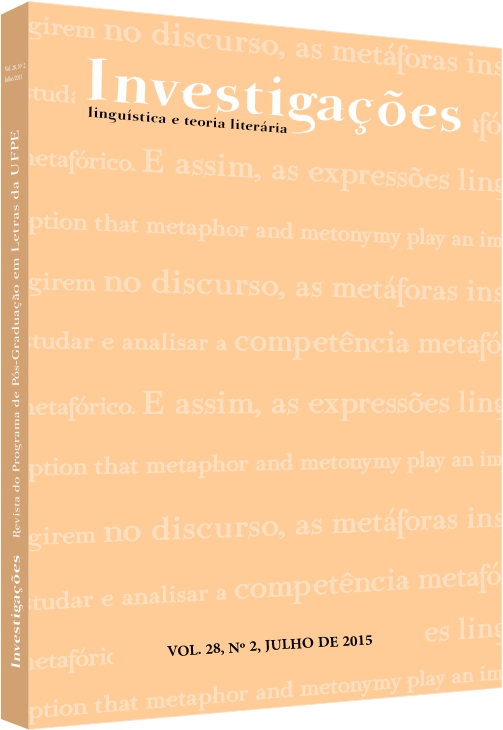Metáforas na linguagem especializada da patente de invenção
Resumo
Partindo dos pressupostos teóricos da Linguística Cognitiva, e, especificamente, da Teoria da Metáfora Conceitual, de Lakoff e Jonhson (1980, 2003), desenvolvemos um trabalho de descrição e análise dos usos metafóricos em documentos de patentes de invenção biotecnológicas europeias. Seguindo as propostas metodológicas da Linguística de Corpus, construímos um corpus de estudo com os textos de 50 patentes, a partir do qual foi possível observar como os redatores de patentes usam vários tipos de metáforas no processo descritivo e reivindicatório de uma patente de invenção.
Palavras-chave: Linguística Cognitiva. Metáfora conceitual. Linguagem especializada. Patentes de invenção.
Referências
ARISTÓTELES. Poética. Tradução: SOUZA, E. de. Porto Alegre: Globo, 1996.
BERBER SARDINHA, Tony. Linguística de Corpus. Baruery, SP: Editora, Manole. 2004.
BOYD, R. Metaphor and theory change: What is ‘metaphor’ a metaphor for? In: ORTONY (Ed.). Metaphor and thought. 2nd ed, Cambridge: Cambridge University Press, p. 481–533. 1993.
CAMERON, L. Metaphor and talk. In: R. W. Gibbs (Ed.), The Cambridge handbook of metaphor and thought. Cambridge etc: Cambridge University Press. 2008
______. Metaphor in educational discourse. London: Continuum. 2003.
CHARTERIS-BLACK, J. Corpus approaches to critical metaphor analysis. London: Palgrave MacMillan. 2004.
CHARTERIS-BLACK, J.; MUSOLFF, A. 'Battered Hero' or 'Innocent Victim'? A comparative study of metaphors for euro trading in British and German financial reporting. English for Specific Purposes, v. 22, p. 153-176, 2003.
FALEIRO, F.; ANDRADE, S. (eds). Biotecnologia: estado da arte e aplicações na agropecuária. Planaltina, DF: Embrapa Cerrados, 2011.
GIBBS, R. (Ed.). Cambridge handbook of metaphor and thought. New York: Cambridge University Press, 2008.
______.The poetics of mind: Figurative thought, language, and understanding. New York: Cambridge University Press, 1994.
GILES, T.D. Motives for Metaphor in Scientific and Technical Communication. Amityville, NY: Baywood Publishing, 2008. 178 p.
GOATLY, A. The language of metaphors. London: Routledge, 1997.
GODDARD, C. The ethnopragmatics and semantics of ‘active metaphors’. Journal of Pragmatics, v. 36, n.7, p. 1211-1230, 2004.
GRADY, J. Foundations of Meaning: Primary metaphors and primary scenes. 1997. 299 f. Tese (Doutorado) - University of California, Berkeley, 1997.
HUANG, Carolina. A metáfora no texto científico de medicina: um estudo terminológico da linguagem sobre AIDS. Programa de Pós-graduação em Letras. Dissertação de Mestrado. 2005.
JOHNSON, Mark. Mind, metaphor, law. Mercer Law Review. v. 58, n. 3, p. 845-868, 2007.
______. The Body in the Mind: the bodily basis of meaning, imagination, and reason. Chicago: University of Chicago Press. 1987.
KNUDSEN, S. Communicating novel and conventional scientific metaphors: a study of the development of the metaphor of genetic code. Public Understanding of Science, v. 14, n. 4, p. 373-392, 2005.
KÖVECSES, Zoltán. Metaphor: a practical introduction. 2nd ed. Nova York: Oxford, 2010. 375 p.
LAKOFF, G. The contemporary theory of metaphor. In: ORTONY, A. (Ed). Metaphor and thought. 2nd ed. Cambridge: Cambridge University Press, 1993.
______. Women, Fire and Dangerous Things: What Categories Reveal about the Mind. Chicago: University of Chicago Press, 1987.
LAKOFF, G.; JOHNSON, M. 2nd ed. Metaphors we live by. Chicago: Chicago University Press, 2003.
______. Metaphors we live by. Chicago: Chicago University Press, 1980.
______. Philosophy in the flesh: The embodied mind and its challenge to western thought. New York: Basic Books, 1999. 508 p. Versão digital.
LIMA, P. L. C. A nova tipologia da metáfora conceitual. Revista de Humanidades e Ciências Sociais da Uece, Fortaleza, v. 5, n. 2, p. 17-26, 2003.
REDDY, M. J. The conduit metaphor- a case of frame conflict in our language about language. In A. Ortony (ed.), Metaphor and Thought. Cambridge, England: Cambridge University Press, p. 284-324, 1979.
SHEN, Y.; BALABAN, N. Metaphorical (in)coherence in discourse. Discourse Processes, v. 28, n.2, p. 139-154, 1999.
STEEN, G. The contemporary theory of metaphor -- now new and improved! Review of Cognitive Linguistics, v. 9, n.1, p. 26-64, 2011a.
______. From three dimensions to five steps: The value of deliberate metaphor. Metaphorik.de, v. 21, 2011b.
______. What does ‘really deliberate’ really mean? More thoughts on metaphor and consciousness. Metaphor and Social World, v. 1, n. 1, p. 53-56, 2011c.
______. The paradox of metaphor: Why we need a three-dimensional model of metaphor. Metaphor and Symbol, v. 23, n. 4, p. 213-241. 2008.
______. When is metaphor deliberate? In N.-L. Johannesson, C. Alm-Arvius, & D. Minugh (Eds.), Selected Papers from the Stockholm 2008 Metaphor Festival, p. 43-63, 2010.
TEMMERMAN, R. Towards New Ways of Terminology Description: The Sociocognitive Approach. Amsterdam/Philadelphia: John Benjamins, 2000.
Downloads
Publicado
Como Citar
Edição
Seção
Licença
Copyright (c) 2015 Jessé de Sousa Mourão, Paula Lenz Costa Lima

Este trabalho está licenciado sob uma licença Creative Commons Attribution 4.0 International License.
Autores que publicam na Revista Investigações concordam com os seguintes termos:
Autores mantêm os direitos autorais e concedem à revista o direito de primeira publicação, com o trabalho simultaneamente licenciado sob a licença Creative Commons Atribuição 4.0 Internacional (CC BY 4.0) que permite o compartilhamento do trabalho com reconhecimento da autoria e publicação inicial nesta revista.
Autores têm autorização para assumir contratos adicionais separadamente, para distribuição não-exclusiva da versão do trabalho publicada nesta revista (exemplo: depositar em repositório institucional ou publicar como capítulo de livro), com reconhecimento de autoria e publicação inicial nesta revista.
Qualquer usuário tem direito de:
Compartilhar — copiar e redistribuir o material em qualquer suporte ou formato para qualquer fim, mesmo que comercial.
Adaptar — remixar, transformar e criar a partir do material para qualquer fim, mesmo que comercial.
O licenciante não pode revogar estes direitos desde que você respeite os termos da licença.
De acordo com os termos seguintes:
Atribuição — Você deve dar o crédito apropriado, prover um link para a licença e indicar se mudanças foram feitas. Você deve fazê-lo em qualquer circunstância razoável, mas de nenhuma maneira que sugira que o licenciante apoia você ou o seu uso.
Sem restrições adicionais — Você não pode aplicar termos jurídicos ou medidas de caráter tecnológico que restrinjam legalmente outros de fazerem algo que a licença permita.

